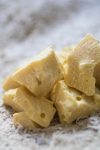Illipé butter stearin (IBS) is a unique and valuable ingredient in the realm of cocoa butter improvers (CBI). With its distinct chemical composition and physical properties, IBS serves as an effective alternative to cocoa butter in various applications within the food industry. To understand the significance of IBS as a CBI, it’s essential to delve into its origins, characteristics, and applications.
Illipe butter is also known as Borneo tallow.
Origins and Extraction:
Illipé butter, from a tree scientifically known as Shorea stenoptera, originates from the nut which is predominantly found in Southeast Asia, particularly in regions like Malaysia and Indonesia. The extraction process involves harvesting the nuts from the trees, which are then cracked open to reveal the kernels within. These kernels undergo pressing or extraction methods to yield illipé butter.
Chemical Composition
IBS contains a unique blend of fatty acids, which contribute to its distinctive properties. The primary fatty acids found in IBS include stearic acid, oleic acid, palmitic acid, and myristic acid. The composition of these fatty acids plays a crucial role in determining the consistency, melting point, and stability of the butter. When this butter fat is used appropriately it can be a cheaper substitute for cocoa butter.
Physical Properties
One of the most notable properties of IBS is its similarity to cocoa butter in terms of consistency and melting behavior. IBS exhibits excellent tempering characteristics, allowing it to solidify into a smooth and glossy texture upon cooling. This property is particularly important in applications where the appearance and texture of the final product are critical, such as chocolate confectionery.
Cocoa Butter Improver (CBI)
In the production of chocolate and other cocoa-based products, cocoa butter plays a vital role in providing texture, mouthfeel, and stability. However, fluctuations in cocoa butter prices and availability can pose challenges for manufacturers. This is where cocoa butter improvers like IBS come into play.
IBS serves as a cost-effective and sustainable alternative to cocoa butter, offering similar functional properties while mitigating the impact of market volatility. By incorporating IBS into chocolate formulations, manufacturers can achieve desired texture and sensory attributes while reducing reliance on cocoa butter. Other replacers and improvers can produce an uncharacteristic waxy mouthfeel when used in compound coatings and chocolate. This particular stearin produces very little waxiness when sensory tested (Podchong et al., 2023).
Applications
IBS finds applications in various food products, with chocolate being one of the primary areas of use. When used as a cocoa butter substitute or extender, IBS helps maintain the structure and consistency of chocolate products while offering cost savings and improved stability.
IBS has been blended with cocoa butter in various weight ratios and solid fat content (SFC) (Podchong et al., 2023). Both fats show monotectic mixing behaviour which is a good indicator of compatability. The solid fat content of cocoa butter is increased at all temperatures by the addition of 10 to 25% IBS. The blend also mets at body temperature. IBS has been added to chocolate at 5% w/w where the hardness, SFC and shape of the chocolate was higher when compared to a typical dark chocolate without IBS. The IBS also slowed down the development of fat bloom compared to the same type of dark chocolate which would be immensely helpful in the improvement of appearance of chocolate over its shelf-life storage.
Apart from chocolate, IBS can also be used in other confectionery items, such as truffles, pralines, and coatings. Its versatility and compatibility with different ingredients make it a valuable component in the formulation of a wide range of food products.
Benefits
The utilization of IBS as a cocoa butter improver offers several benefits to manufacturers:
- Cost Savings: IBS is often more cost-effective than cocoa butter, providing a viable option for reducing production expenses without compromising quality.
- Stability: IBS contributes to the stability of chocolate and confectionery products, enhancing shelf life and reducing the risk of bloom or fat migration. It increases heat resistance of any chocolate where the cocoa butter is partially substituted.
- Sustainability: As an alternative to cocoa butter, IBS helps alleviate pressure on cocoa bean supplies and promotes sustainability within the chocolate industry.
- Consistency: The consistent quality of IBS ensures uniformity in product formulations, allowing manufacturers to maintain desired sensory attributes across batches.
- Versatility: IBS can be used in various applications beyond chocolate, expanding its potential uses within the food industry.
Illipé butter stearin (IBS) serves as a valuable cocoa butter improver (CBI) due to its unique properties, cost-effectiveness, and versatility. As an alternative to cocoa butter, IBS offers manufacturers a sustainable solution for maintaining product quality while managing costs and ensuring stability. With its widespread applications in chocolate and confectionery products, IBS plays a significant role in shaping the future of the food industry, offering opportunities for innovation and sustainability.
References
Podchong, P., Chalermchadpokin, C., Sonwai, S., & Ueno, S. (2023). Improvement of chocolate heat resistance with illipé butter stearin addition. International Journal of Food Science & Technology, 58(4), pp. 1868-1878 (Article).

Leave a Reply